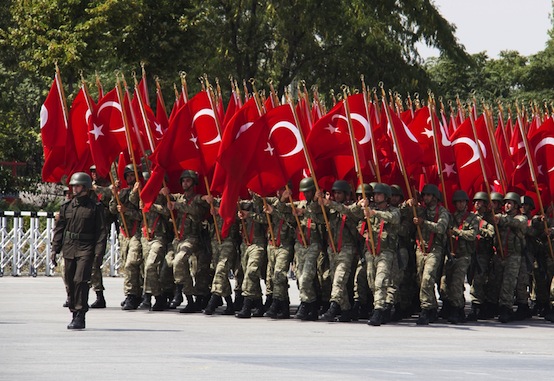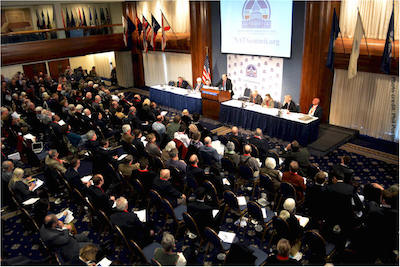Turkey Cooks the Books in Syria
Apr 23 2014 / 8:53 pm
Seymour Hersh documents Ankara’s efforts to pull the U.S. into the Levant.
By Philip Giraldi.
The American Conservative – If you had been a reader of The American Conservative magazine back in December 2011, you might have learned from an article written by me that “Unmarked NATO warplanes are arriving at Turkish military bases close to Iskenderum on the Syrian border, delivering weapons [to the Free Syrian Army] derived from Colonel Muammar Gaddafi’s arsenals…” Well, it seems that the rest of the media is beginning to catch up with the old news, supplemented with significant details by Sy Hersh in the latest issue of the London Review of Books in an article entitled “The Red Line and the Rat Line.”
The reality is that numerous former intelligence officials, like myself, have long known most of the story surrounding the on-again off-again intervention by the United States and others in Syria, but what was needed was a Sy Hersh, with his unmatched range of contacts deep in both the Pentagon as well as at CIA and State Department, to stitch it all together with corroboration from multiple sources. In a sense it was a secret that wasn’t really very well hidden but which the mainstream media wouldn’t touch with a barge pole because it revealed that the Obama Administration, just like the Bushies who preceded it, has been actively though clandestinely conspiring to overthrow yet another government in the Middle East. One might well conclude that the White House is like the Bourbon Kings of France in that it never forgets anything but never learns anything either.
The few media outlets that are willing to pick up the Syria story even now are gingerly treating it as something new, jumping in based on their own editorial biases, sometimes emphasizing the CIA and MI6 role in cooperating with the Turks to undermine Bashar al-Assad. But Hersh’s tale is only surprising if one had not been reading between the lines over the past three years, where the clandestine role of the British and American governments was evident and frequently reported on over the internet and, most particularly, in the local media in the Middle East. Far from being either rogue or deliberately deceptive, operations by the U.S. and UK intelligence services, the so-called “ratlines” feeding weapons into Syria, were fully vetted and approved by both the White House and Number 10 Downing Street. The more recent exposure of the Benghazi CIA base’s possible involvement in obtaining Libyan arms as part of the process of equipping the Syrian insurgents almost blew the lid off of the arrangement but somehow the media attention was diverted by a partisan attack on the Obama Administration over who said what and when to explain the security breakdown and the real story sank out of sight.
So this is what happened, roughly speaking: the United States had been seeking the ouster of President Bashar al-Assad of Syria since at least 2003, joining with Saudi Arabia, which had been funding efforts to destabilize his regime even earlier. Why? Because from the Saudi viewpoint Syria was an ally of Iran and was also a heretical state led by a secular government dominated by Alawite Muslims, viewed as being uncomfortably close to Shi’ites in their apostasy. From the U.S. viewpoint, the ties to Iran and reports of Syrian interference in Lebanon were a sufficient casus bellicoupled with a geostrategic assessment shared with the Saudis that Syria served as the essential land bridge connecting Hezbollah in Lebanon to Iran. The subsequent Congressional Syria Accountability Acts of 2004 and 2010, like similar legislation directed against Iran, have resulted in little accountability and have instead stifled diplomacy. They punished Syria with sanctions for supporting Hezbollah in Lebanon and for its links to Tehran, making any possible improvement in relations problematical. The 2010 Act even calls for steps to bring about regime change in Damascus.
The United States also engaged in a program eerily reminiscent of its recent moves to destabilize the government in Ukraine, i.e., sending in ambassadors and charges who deliberately provoked the Syrian government by meeting with opposition leaders and openly making demands for greater democracy. The last U.S. Ambassador to Syria Robert Ford spoke openly in support of the protesters while serving in Damascus in 2010. On one occasion he was pelted with tomatoes and was eventually removed over safety concerns.
Lost in translation is the fact that Washington’s growing support for radical insurgency in Syria would also inevitably destabilize all its neighbors, most notably including Iraq, which has indeed been the case, making a shambles of U.S. claims that it was seeking to introduce stable democracies into the region. Some also saw irony in the fact that a few years before Washington decided al-Assad was an enemy it had been sending victims of the CIA’s rendition program to Syria, suggesting that at least some short-term and long-term strategies were on a collision course from the start, if indeed the advocates of the two policies were actually communicating with each other at all.
Prime Minister Recep Tayyip Erdogan of Turkey, whose country shared a long border with Syria and who had legitimate security concerns relating to Kurdish separatists operating out of the border region, became the proxy in the secret war for Washington and its principal European allies, the British and French. When the U.S.-Saudi supported insurgency began to heat up and turn violent, Turkey became the key front line state in pushing for aggressive action against Damascus. Erdogan miscalculated, thinking that al-Assad was on his last legs, needing only a push to force him out, and Ankara saw itself as ultimately benefiting from a weak Syria with a Turkish-controlled buffer zone along the border to keep the Kurds in check.
Hersh reports how President Barack Obama had to back down from attacking Syria when the Anglo-American intelligence community informed him flatly and unambiguously that Damascus was not responsible for the poison gas attack that took place in Damascus on August 21, 2013 that was being exploited as a casus belli. The information supporting that assertion was known to many like myself who move around the fringes of the intelligence community, but the real revelation from Hersh is the depth of Turkish involvement in the incident in order to have the atrocity be exploitable as a pretext for American armed intervention, which, at that point, Erdogan strongly desired. As the use of weapons of mass destruction against civilians was one of the red lines that Obama had foolishly promoted regarding Syria Erdogan was eager to deliver just that to force the U.S.’s hand. Relying on unidentified senior U.S. intelligence sources, Hersh demonstrates how Turkey’s own preferred militant group Jabhat al-Nusra, which is generally regarded as an al-Qaeda affiliate, apparently used Turkish-provided chemicals and instructions to stage the attack.
Is it all true? Unless one has access to the same raw information as Sy Hersh it is difficult to say with any certainty, but I believe I know who some of the sources are and they both have good access to intelligence and are reliable. Plus, the whole narrative has an undeniable plausibility, particularly if one also considers other evidence of Erdogan’s willingness to take large risks coupled with a more general Turkish underhandedness relating to Syria. On March 23rd, one week before local elections in Turkey that Erdogan feared would go badly for him, a Turkish air force F-16 shot down a Syrian Mig-23, claiming that it had strayed half a mile into Turkish airspace. The pilot who bailed out, claimed that he was attacking insurgent targets at least four miles inside the border when he was shot down, an assertion borne out by physical evidence as the plane’s remains landed inside Syria. Was Erdogan demonstrating how tough he could be just before elections? Possibly.
And then there are the YouTube recordings. Three days before the election, a discussion not unlike the Victoria Nuland leak in Ukraine surfaced. A conversation between Foreign Minister Ahmet Davutoglu and Hakan Fidan, the chief of the Turkish National Intelligence Organization (MIT), included Davutoglu saying that the “Prime Minister said that in the current conjuncture of time, this attack [on the Tomb of Suleiman Shah] must be seen as an opportunity for us.” Davutoglu was clearly referring to an attack on the tomb serving as a pretext for a Turkish incursion into Syria. Fidan then declared that “I will send four men from inside Syria, if that is what it will take. I will make up a reason for war by ordering a missile attack on Turkey. We can also prepare a direct attack on the Tomb of Suleiman Shah if necessary.” The recording reveals that Ankara was considering staging a false flag attack on the tomb of Suleiman Shah, the grandfather of Osman I, the founder of the Ottoman dynasty. The tomb is in Syria but because of its historical importance has been regarded as sovereign Turkish territory, much like an Embassy, and is guarded by Turkish soldiers. So the suggestion is that Ankara was prepared to kill its own soldiers to create an incident that would have led to a broader war.
Critics of Hersh claim that the Turks would be incapable of carrying out such a grand subterfuge, but I would argue that putting together some technicians, chemicals, and a couple of trucks to carry the load are well within the capability of MIT, an organization that I have worked with and whose abilities I respect. And one must regard with dismay the “tangled webs we weave,” with due credit to Bobby Burns, for what has subsequently evolved in Syria. Allies like Turkey that are willing to cook the books to bring about military action are exploiting the uncertainty of a White House that continues to search for foreign policy successes while simultaneously being unable to define any genuine American interests. Syria is far from an innocent in the ensuing mayhem, but it has become the fall guy for a whole series of failed policies. Turkey meanwhile has exploited the confusion to clamp down on dissent and to institutionalize Erdogan’s authoritarian inclinations. Ten years of American-licensed meddling combined with obliviousness to possible consequences has led to in excess of 100,000 dead Syrians and the introduction of large terrorist infrastructures into the Arab heartland, yet another foreign policy disaster in the making with no clear way out.

